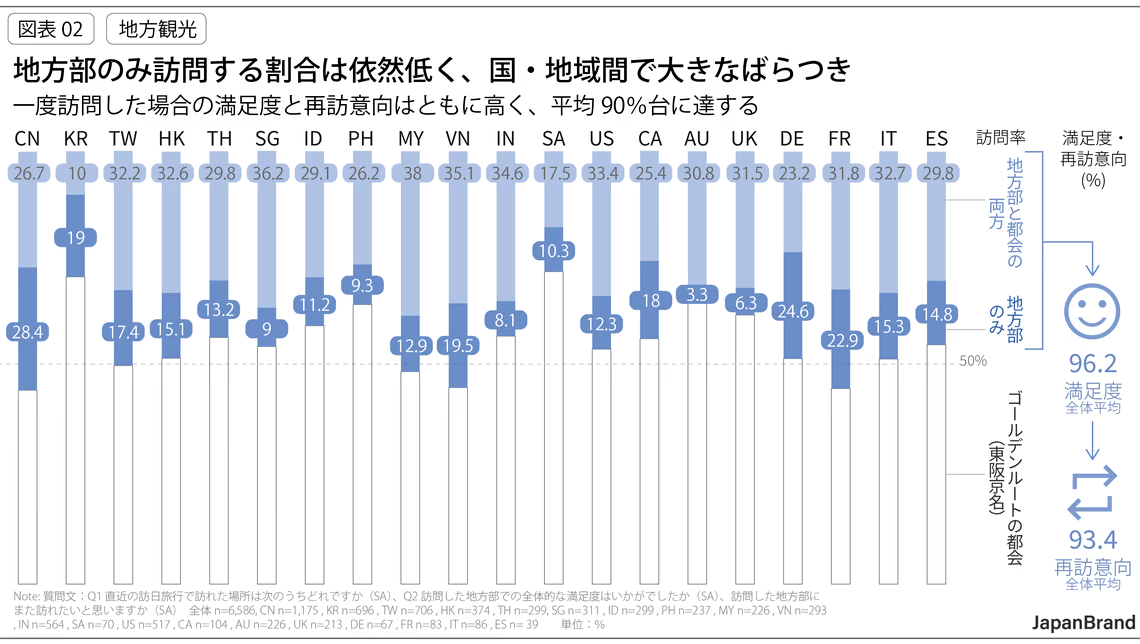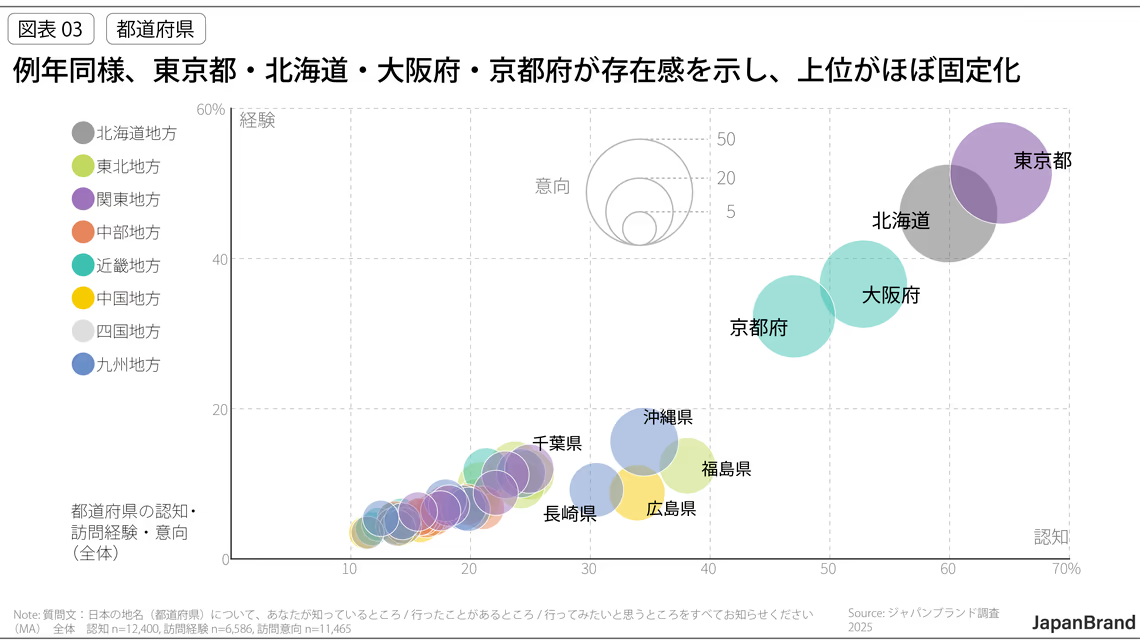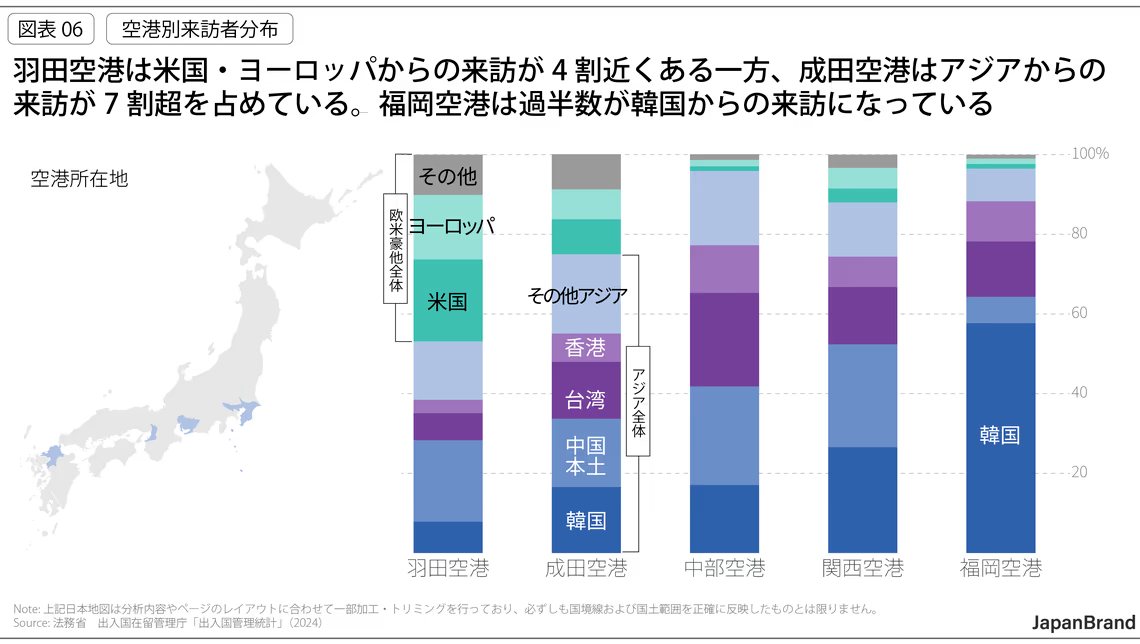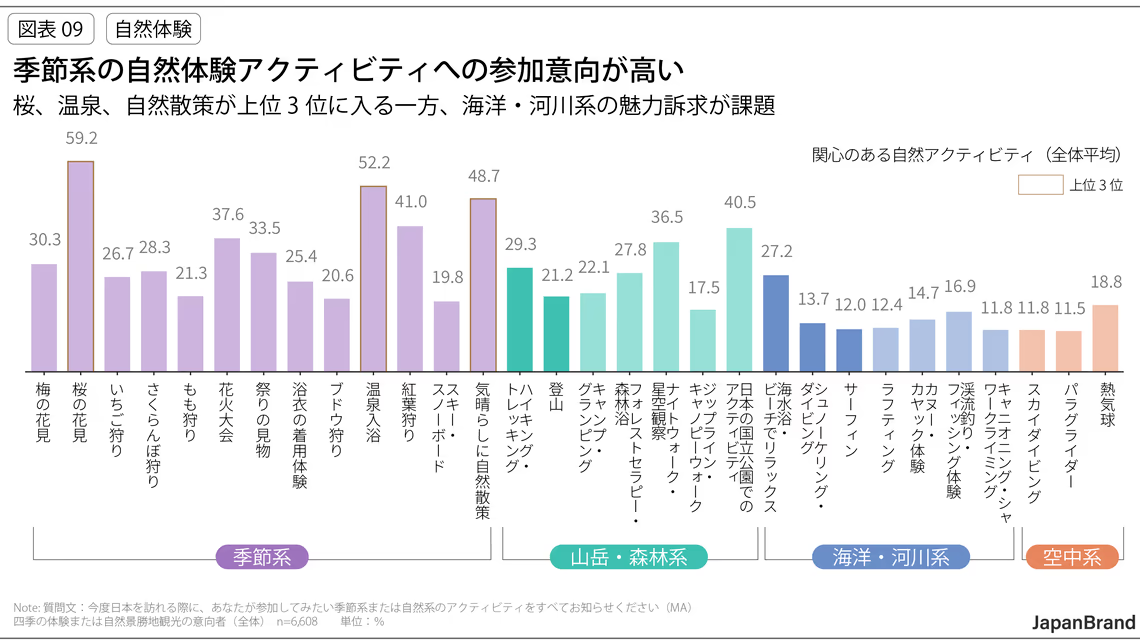Note: This website was automatically translated, so some terms or nuances may not be completely accurate.
Traveling between cities and rural areas is becoming a new highlight of Japan travel. Three perspectives to encourage inbound travel to regional areas.
The Japan Brand Survey is a large-scale overseas survey developed by Dentsu Inc. and launched in 2011. Its purpose is to understand the attitudes and realities of overseas residents regarding Japan as a whole, including inbound tourism, regional revitalization, the food sector, Japanese products, content, values, lifestyles, and social trends. Now in its 15th year, the Japan Brand Survey 2025 covers the largest number of countries and regions to date: 20 ( Survey Overview ), over 20 industry sectors, and more than 10 themes.
In the first session focused on tourism and a sustainable future, presenting a broad overview of the findings.
This second installment focuses on "Regional Tourism," highlighting the importance of "regions" in achieving sustainable tourism. We will introduce perspectives from overseas residents revealed by the survey and key viewpoints to consider for attracting more visitors. We hope this serves as a reference for tourism operators, local governments, and others nationwide working to attract international visitors to Japan.
<Table of Contents>
▼"Regional Travel" is an Essential Piece for Sustainable Inbound Tourism
▼Over 90% Satisfaction & Intent to Return! Traveling "Around the Regions" is the True Essence of Japan
▼Key Perspectives to Consider for Encouraging "Regional Travel": Route, Season, and Content
▼"Travels Connecting Cities and Regions" Build Sustainable Inbound Tourism
Regional Travel is an Essential Piece for Sustainable Inbound Tourism
In 2024, the number of foreign visitors to Japan reached a record high of 36.87 million. This surpasses the previous peak of 31.88 million set in 2019 before the pandemic and represents more than a tenfold increase from the 3.34 million recorded 30 years ago in 1995.The first half of 2025 (January-June) already saw a record high of approximately 21.51 million visitors, maintaining a pace that could reach 40 million for the full year.
However, a closer look at the breakdown reveals a significant regional imbalance in visitor destinations. Data released by the Japan Tourism Agency shows the number of international visitors by prefecture for 2024.Tokyo ranked first with 14.46 million visitors, followed by Osaka Prefecture with 12.88 million, and Chiba Prefecture with 10.64 million, showing a clear concentration in metropolitan areas. In contrast, the bottom rankings were Shimane Prefecture with 43,000 visitors, Fukui Prefecture with 52,000, and Kochi Prefecture with 71,000.

This excessive concentration of visitors has significant impacts on local communities. While "overtourism" has long been recognized as a social issue, the overconcentration of tourists causes "environmental impacts" such as severe traffic congestion and increased waste, as well as "economic impacts" like rising prices at hotels and restaurants.
In response to this situation, the Japan Tourism Agency announced in 2023 the Measures Package for Preventing and Mitigating Overtourism " in 2023, with one of its pillars being "Promoting Visitor Attraction to Regional Areas."
Beyond revitalizing regional economies, with inbound tourists projected to exceed 40 million in 2025, "regional circulation" is an essential piece of the puzzle for achieving sustainable tourism where "it's good to live and good to visit." is an essential piece of the national tourism promotion puzzle.
Over 90% satisfaction & intent to revisit! Traveling around regional areas is the true essence of Japan
The Japan Brand Survey 2025 reveals differences in regional visitation trends by country and highlights the value of "regional travel" from the user's perspective.
When asking overseas residents with Japan visit experience whether their most recent trip was "urban areas only (Tokyo, Osaka, Kyoto, Nagoya)", "rural areas only", or "both", significant variations emerged across countries and regions. For example, within East Asia, approximately 70% of South Korean visitors traveled "urban areas only", while around 50% of visitors from mainland China, Taiwan, and Hong Kong visited "rural areas".
Among visitors who traveled to regional areas, satisfaction with regional tourism reached 96.2%, and 93.4% expressed a desire to revisit. This demonstrates high satisfaction and strong revisit intent for regional tourism. This trend was consistent across all surveyed countries and regions. These figures suggest that encouraging travel to regional areas is a win-win initiative: it not only promotes sustainable tourism in Japan but also leads to highly satisfying visit experiences from the visitor's perspective.

On the other hand, a clear challenge remains: among overseas residents, awareness of and visit intentions for regional areas are significantly lower compared to urban centers. By prefecture, Tokyo overwhelmingly leads in awareness, experience, and visit intentions, followed by Hokkaido, Osaka Prefecture, and Kyoto Prefecture, which also stand out significantly above other prefectures.

The Japan Brand Survey 2025 similarly surveyed major cities. Sapporo City, Osaka City, and Kyoto City again boast exceptionally high awareness, experience, and intention. While Fukushima City, Yokohama City, and Hiroshima City show relatively higher awareness, there is little difference in experience or intention.

So, when thinking, "Let's get our region noticed to attract visitors!", it's natural to wonder what to do for diverse overseas markets. It's also reasonable to assume that budgets are relatively limited compared to urban municipalities and tourism operators. Therefore, this time, we utilize public statistics and the Japan Brand Survey to introduce three key perspectives to consider when promoting regional travel. to encourage regional travel.
Perspectives to Consider for Promoting "Regional Travel": Route, Season, and Content
Key perspectives to consider when attracting international visitors to regional areas:
"Route (What physical pathways enable visitors to reach regional areas?)"
"Season (When do visitors particularly want to come?)"
"Content (What attractions or experiences are likely to be particularly appealing to visitors?)"
are three key perspectives to consider.
First, the "Route" perspective. The biggest difference between regional areas and urban centers lies in "accessibility from overseas," or in other words, "transportation capacity for inbound visitors."
While Japan has 97 airports, looking at the number of international passenger scheduled flights for summer 2025 (as announced by the Ministry of Land, Infrastructure, Transport and Tourism) by airport shows that Narita International Airport and Tokyo International Airport (Haneda) account for about 50%. Kansai International Airport has 25.5%, Chubu Centrair International Airport has 5.8%, Fukuoka Airport has 8.4%, and other regional airports account for 12.1%.

While many airports nationwide lack international flights, this shows that the entry points for inbound tourists are somewhat limited. Regional tourist destinations should first consider the perspective of "which airport(s) and surrounding areas" they can attract visitors from. For example, a tourist spot in Kyushu should consider attracting visitors not only from the nearest airport with international flights but also from Fukuoka Airport.
Furthermore, it is useful to understand "which countries and regions visitors to Japan are coming from" for each airport. The Ministry of Justice publishes Immigration Control Statistics allow analysis of visitors by country/region for each airport.
For instance, nearly 40% of visitors to Haneda Airport come from the US and Europe, while 70% of visitors to Narita Airport come from Asia. Furthermore, over half of visitors to Fukuoka Airport come from South Korea, clearly showing distinct regional trends.
Therefore, for regions like Kyushu, promoting and developing infrastructure with Korean tourists in mind seems essential.

Visitors arriving at the nearest major airport form the base target market. From there, considering the land transportation network and capacity via buses, trains, and bullet trains provides a perspective for analyzing target countries and regions in regional areas.
Next is the seasonal perspective. The top experiences of interest for inbound travel are: 1st place "Eating Japanese cuisine," 2nd place "Natural scenic spots," and 3rd place "Experiencing the four seasons."

The table above also reveals characteristics by country/region. Interest in Japanese cuisine is high overall, including in Europe, America, and Australia, while experiencing the four seasons is particularly popular in Southeast Asia, where the climate differs significantly. Since Japanese cuisine and natural scenic spots are highly associated with "seasons" and "seasonal produce," identifying the optimal "season" to attract visitors is crucial.
For overseas residents, the season they most want to visit Japan is "cherry blossom season," with "enjoying scenery unique to that season" being the top reason for visiting. However, interest in the next most popular time to visit Japan after cherry blossom season tends to vary by country/region. Europe and America show high interest in the "summer vacation season," while Southeast Asia and Taiwan show high interest in the "snow season."Focusing on seasonal appeal, target audiences, and attractions will be a key perspective for regional tourism promotion.

Finally, the "content" perspective. As mentioned earlier, interest in "natural scenic spots" and "experiencing the four seasons" was high in Japan travel experiences. Let's examine interest in "nature experiences" in more detail.
Figure 9 shows that following "cherry blossom viewing," activities like "hot spring bathing," "nature walks," "autumn foliage viewing," "fireworks festivals," "stargazing," and "fruit picking" are popular. There remains room to capture more attention for activities in mountainous, marine, and river environments.

Japan is characterized by a natural environment where forests cover two-thirds of the land, featuring many mountains and abundant rivers. Refining experiences that leverage these characteristics appears to be a nationwide challenge. In recent years, the value of less crowded areas and undiscovered scenery has also increased. Therefore, it might be worthwhile to take another look at natural scenic spots in regional areas.

Reference: What Makes Japan Brands Shine in Regional Areas? 3+1 Strategies to Attract International Visitors to Regional Japan
"Journeys Between City and Countryside" Build Sustainable Inbound Tourism
This time, focusing on "Regional Tourism in Japan," we examined its potential for sustainable tourism and visitor satisfaction, along with three perspectives for further attracting visitors to regional areas, based on official statistics and survey results. Amid concerns about overtourism, dispersing inbound tourism across regions and seasons will remain a major theme. Furthermore, since visitors' satisfaction and willingness to revisit are high for regional tourism, it becomes a crucial factor in securing repeat visitors.
Beyond just "regional tourism," promoting tourism must, as advocated by the Japan Tourism Agency, be advanced with consideration for local residents—ensuring it is "good to live in and good to visit." Within this framework, the current domestic momentum for promoting "regional tourism" through public-private collaboration can be seen as a once-in-a-lifetime opportunity to get even more people to fall in love with their own regions.
As the Japan Brand Project Team, we aim to contribute to the sustainable promotion of regional tourism, not limited to the perspective of "Route, Season, Content" presented this time.
【Contact for Inquiries Regarding This Matter】
Dentsu Inc. Japan Brand Project Team
japanbrand@dentsu.co.jp
[Purpose of the Dentsu Inc. Japan Brand Survey]
Dentsu Inc.'s proprietary survey initiated in 2011 to understand how the Japan Brand was perceived globally when reputational damage occurred to Japanese agricultural and marine products and inbound travel following the Great East Japan Earthquake. In 2022, it evolved into a cross-company project activity to enhance expertise through a fundamental restructuring of the survey design, analytical approach, and outputs.In 2025, it aims to create new social value grounded in consumer insights by planning and building a new knowledge portfolio for the general public.
The Japan Brand Survey regularly gauges overseas consumers' perceptions and behaviors regarding Japan's lifestyle, social trends, and the Japan Brand as a whole. It visualizes the evolving sentiments of consumers and the challenges and potential of the Japan Brand, contributing to increasingly complex corporate activities while also shedding light on the challenges and opportunities facing Japanese society. Lifestyle, and social trends. It visualizes the evolving sentiments of consumers and the challenges and potential of the Japan Brand, contributing to increasingly complex corporate activities while also promoting cross-cultural understanding within Japanese society.
【Dentsu Inc. Japan Brand Survey 2025: Survey Overview】
・Target Areas: 20 countries/regions※1 (United States, Canada, Australia, United Kingdom, Germany, France, Italy, Spain, Saudi Arabia, India, Indonesia, Singapore, Malaysia, Philippines, Thailand, Vietnam, Mainland China, Hong Kong, Taiwan, South Korea)
・Respondent Criteria: Men and women aged 20–59 (middle-income and above)※2
・Sample Size: 12,400 (Breakdown: US & Mainland China: 1,600 each, India: 1,200, South Korea, Taiwan, UK: 800 each, Other countries/regions: 400 each) ※3
・Survey Method: Online survey
・Survey Period: May 20 to June 22, 2025
・Research Organizations: Dentsu Inc. (Principal Investigator), Video Research Ltd. (Implementation Support)
[Notes and Disclaimers]
※1: Mainland China covers Shanghai, Suzhou, Beijing, Tianjin, Guangzhou, Shenzhen, Chengdu, and Chongqing; India covers Delhi, Mumbai, and Bengaluru; Australia covers the Sydney metropolitan area; Southeast Asia is primarily limited to metropolitan areas.
※2: Definition of Middle Income: Conditions set per country based on national average income (e.g., OECD statistics) and social class classification (SEC).
※3: Samples were collected with equal allocation by gender and age group across all countries/regions, then weighted to match the population composition.
※4: Proportions in this survey are rounded to the second decimal place (or first decimal place for some integer values), so totals may not add up to 100%.
※5: Country and region names used in this survey report and on the website follow the longstanding views of the Japanese government, as well as Japanese social norms and business practices.
※6: In creating the charts and graphs for this survey, the names of the countries and regions analyzed use the international standard ISO Country Code (ISO 3166-1 alpha-2), with some exceptions.
United States/US, Canada/CA, Australia/AU, United Kingdom/UK, Germany/DE, France/FR, Italy/IT, Spain/ES, Saudi Arabia/SA, India/IN, Indonesia/ID, Singapore/SG, Malaysia/MY, Philippines/PH, Thailand/TH, Vietnam/VN, Mainland China/CN, Hong Kong/HK, Taiwan/TW, South Korea/KR
※7: Country and region names used in this survey are for statistical or analytical convenience only and do not indicate any political stance or viewpoint.
※8: The maps used in this survey (world map and Japan map) have been partially modified and cropped to suit the analysis content and page layout. They do not necessarily accurately reflect national borders or territorial boundaries.
Was this article helpful?
Newsletter registration is here
We select and publish important news every day
For inquiries about this article
Author

Usui Kenta
Dentsu Inc.
Marketing Division 4, Marketing Consulting Division 3
Marketing Consultant
After working as an analyst and planner at a railway advertising company, he joined Dentsu Inc. He has experience promoting regional appeal through marketing and branding for over 20 public sector entities—from central government ministries to local municipalities—as well as the transportation and hospitality industries. He specializes in public-private co-creation leveraging research and facilitation. He is a certified tourism planner by the Japan Tourism Association and a member of the "Dentsu Japan Brand Survey."


